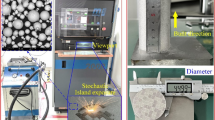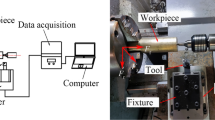Abstract
This paper proposes a new effective dry cutting tool named tungsten disulfide (WS2) soft-coated nano-textured self-lubricating tool which is fabricated by two steps. First, nano-texture is made on the tool–chip interface of rake face of uncoated YS8 (WC + TiC + Co) cemented carbide cutting inserts by femtosecond laser micromachining technology. Second, WS2 soft coating is deposited on the nano-textured tool by medium-frequency magnetron sputtering, multi-arc ion plating and ion beam assisted deposition technique. Dry turning tests on 45# quenched and tempered steel were carried out with three kinds of cutting tools: conventional YS8 tool, nano-textured tool (CFT), and WS2 soft-coated nano-textured self-lubricating tool (CFTWS). Results show that the cutting forces, cutting temperature, the friction coefficient at the tool–chip interface, and the antiadhesive effect of the nano-textured tools were significantly reduced compared with those of the conventional one. The CFTWS tool had the best cutting performance among all the tools tested under the same test conditions. Through cutting force and cutting temperature theoretical analysis and experimental results, four mechanisms responsible were found. The first one is explained as the formation of the WS2 lubricating film with low shear strength at the tool–chip interface, which was released from the surface nano textures and smeared on the rake face, and served as lubricating additive during dry cutting processes to reduce the cutting forces and cutting temperature. The second one is explained by the reduced contact length at the tool–chip interface of the nano-textured tools; the smaller direct contact area between the chip and tool rake face leads to less friction force, which can also contribute to the decrease of cutting forces and cutting temperature. The third one can be explained that because of the excellent lubricity of the WS2 lubricating film, the antiadhesive effect can be significantly improved which can reduce adhesive wear of the cutting tool and prolong the tool life. The fourth one can be explained that the advantage of CFTWS tool in cutting forces and cutting temperature is obvious in relatively high-speed and high-temperature conditions may be because of ultra-low friction coefficient, high temperature resistance, and the high oxidation resistance of WS2 soft coating which is not sensitive to high cutting temperature and high cutting speed can significantly improve the severe dry cutting environment.
Similar content being viewed by others
References
Chen RY (1992) Principle of metal cutting. China Machine, Beijing
Deng JX, Song WL, Zhang H (2009) Design, fabrication and properties of a self-lubricated tool in dry cutting. Int J Mach Tools Manuf 49(1):66–72
Liu ZF, Zhang CG, Ren JL (2005) Dry machining technology and application. China Machine, Beijing
Deng JX, Ai X, Feng YH (2002) Wear lubrication and matching of cutting tools with the work piece materials. Chin J Mech Engin 38(4):40–45
Zhao J, Ai X, Lu ZJ (2006) Preparation and characterization of Si3N4/TiC nanocomposite ceramics. Mater Lett 60(23):2810–2813
Li B, Deng JX, Wu Z (2010) Effect of cutting atmosphere on dry machining performance with Al2O3/ZrB2/ZrO2 ceramic tool. Int J Adv Manuf Technol 49(5–8):459–467
Renevier NM, Hamphire J, Fox VC, Witts J, Allen T, Teer DG (2001) Advantages of using self-lubricating, hard, wear-resistant MoS2-based coatings. Surf Coat Tech 142–144:67–77
Renevier NM, Oosterling H (2003) Performance and limitations of MoS2/Ti composite coated inserts. Surf Coat Tech 172(1):13–23
Song WL, Deng JX, Wu Z, Zhang H, Yan P, Zhao J, Ai X (2011) Cutting performance of cemented-carbides-based self-lubricated tool embedded with different solid lubricants. Int J Adv Manuf Technol 52(5–8):477–485
Deng JX, Cao TK, Yang XF (2006) Self lubrication of sintered ceramic tools with CaF2 additions in dry cutting. Int J Mach Tools Manuf 46(9):957–963
Basnyat P, Luster B, Muratore C, Voevodin AA, Haasch R, Zakeri R, Kohli P, Aouadi SM (2008) Surface texturing for adaptive solid lubrication. Surf Coat Tech 203(1–2):73–79
Shen C, Huang W, Ma GL, Wang XL (2009) A novel surface texture for magnetic fluid lubrication. Surf Coat Tech 204(4):433–439
Pettersson U, Jacobson S (2003) Influence of surface texture on boundary lubricated sliding contacts. Tribol Int 36(11):857–864
Wang Y, Mo YF, Zhu M, Bai MW (2008) Wettability of metal coatings with biomimic micro textures. Surf Coat Tech 203(1–2):137–141
Lei S, Devarajan S, Chang ZH (2009) A study of micropool lubricated cutting tool in machining of mild steel. J Mater Process Technol 209(3):1612–1620
Enomoto T, Sugihara T (2010) Improving anti-adhesive properties of cutting tool surfaces by nano-/micro-textures. CIRP Ann Manuf Technol 59(1):597–600
Sugihara T, Enomoto T (2009) Development of a cutting tool with a nano/micro-textured surface-improvement of anti-adhesive effect by considering the texture patterns. Preci Engin 33(4):425–429
Kawasegi N, Sugimori H, Morimoto H, Morita N, Hori I (2009) Development of cutting tools with microscale and nanoscale textures to improve frictional behavior. Preci Engin 33(3):248–254
Koshy P, Tovey J (2011) Performance of electrical discharge textured cutting tools. CIRP Ann Manuf Technol 60(1):153–156
Deng JX, Wu Z, Lian YS, Qi T, Cheng J (2012) Performance of carbide tools with textured rake-face filled with solid lubricants in dry cutting processes. J Refract Met Hard Mater 30(1):164–172
Martins RC, Paulo SM, Seabra JQ (2006) MoS2/Ti low-friction coating for gears. Tribol Int 39(12):1686–1697
Song WL, Deng JX, Zhang H, Yan P (2010) Study on cutting forces and experiment of MoS2/Zr-coated cemented carbide tool. Int J Adv Manuf Technol 49(9–12):903–909
Sadale SB, Patil PS (2006) Synthesis and characterization of type-II textured tungsten disulfide thin films by vdWR process with Pb interfacial layer as texture promoter. J Crystal Growth 290(2):363–368
Lian YS, Deng JX, Li SP (2012) Influence of the deposition temperature on the properties of medium-frequency magnetron sputtering WS2 soft coated tools. Adv Mater Res 472–475:44–49
Shaw MC (1984) Metal cutting principles. Oxford University Press, New York
Nakayama K (1985) Principle of metal cutting. China Machine, Beijing
Zhou ZH (1992) Metal-cutting principles. China Machine, Beijing
Author information
Authors and Affiliations
Corresponding author
Rights and permissions
About this article
Cite this article
Lian, Y., Deng, J., Yan, G. et al. Preparation of tungsten disulfide (WS2) soft-coated nano-textured self-lubricating tool and its cutting performance. Int J Adv Manuf Technol 68, 2033–2042 (2013). https://doi.org/10.1007/s00170-013-4827-y
Received:
Accepted:
Published:
Issue Date:
DOI: https://doi.org/10.1007/s00170-013-4827-y




